Reserve Bank of Australia Annual Report – 1993 The Economy and Monetary Policy
The economy entered 1992/93 in the early stage of recovery with the lowest inflation in decades. The aim of monetary policy during the year was to encourage a sustainable pick-up in the rate of recovery, while holding on to the gains on inflation. To this end, interest rates were reduced on two occasions, in response to additional evidence of both continuing low inflation and sluggishness in the pace of growth.
The more modest easing over the past 12 months, relative to the preceding three years, reflected several factors. By the middle of 1992, short-term interest rates already had fallen by almost 12 percentage points in two and a half years, with beneficial effects on many borrowers. Moreover, while the rise in output was disappointing for this stage of the recovery, it was stronger than in the previous two years and was expected to gather some momentum as the year progressed. Finally, the behaviour of the exchange rate assumed more importance during the year because of the potentially disruptive effects of large and sudden falls on confidence and medium-term inflation objectives.
| 1989/90 | |
|---|---|
| 23 January 1990 | ½–1 |
| 15 February 1990 | ½ |
| 4 April 1990 | 1–1½ |
| 1990/91 | |
| 2 August 1990 | 1 |
| 15 October 1990 | 1 |
| 18 December 1990 | 1 |
| 4 April 1991 | ½ |
| 16 May 1991 | 1 |
| 1991/92 | |
| 3 September 1991 | 1 |
| 6 November 1991 | 1 |
| 8 January 1992 | 1 |
| 6 May 1992 | 1 |
| 1992/93 | |
| 8 July 1992 | ¾ |
| 23 March 1993 | ½ |
By mid 1992, the Australian dollar had depreciated by around 8 per cent compared with a year earlier. This decline was in line with trends in interest rate differentials and Australia's terms of trade, and did not prevent a lowering of domestic interest rates in July. By the end of August, however, the Australian dollar had declined further, taking the total fall over a 12-month period to around 15 per cent. Further large falls on the back of that decline would have carried risks, especially for inflation and inflationary expectations.
It is logical that weakening terms of trade and narrowing interest differentials should have led to a lower Australian dollar exchange rate. Monetary policy has recognised this, and has not attempted to hold the exchange rate at unrealistic levels. Instead, it has sought, as far as possible, to facilitate the process of exchange rate adjustment in an orderly way so as not to undermine confidence in the coherence of policy. The maintenance of low inflation and the restoration of business confidence both required, inter alia, the avoidance of large and sudden exchange rate shocks.
When strong downward pressure on the currency threatened these broader objectives, the Bank responded by intervening in the foreign exchange market (see next chapter) and, on occasions, by deferring consideration of possible further reductions in interest rates.
The Board considered but did not pursue the possibility of raising interest rates to help counter pressures on the Australian dollar. For one thing, monetary policy was already quite firm, with high real interest rates, particularly for those borrowing from banks, and flat credit and monetary aggregates. At the same time, economic activity was not picking up to the extent expected while inflation, if anything, was showing signs of further moderation. With economic activity recovering only gradually and inflation under control, the conditions were quite different from those prevailing in Australia in 1985, mid 1986 and early 1987 when short-term interest rates were raised sharply to help stabilise the exchange rate.

The proper application of monetary policy must ultimately be to help stabilise prices and avoid large swings in economic activity. In any open economy, exchange rate developments will often be prominent in assessing the monetary policy settings which best contribute to those objectives but internal conditions will usually dominate. In the circumstances which prevailed in 1992/93, a substantial tightening in monetary policy aimed at supporting the exchange rate would have further burdened an already struggling recovery. The Board, therefore, judged that the balancing of domestic policy objectives and exchange rate considerations would be best achieved through foreign exchange intervention and holding interest rates steady.

This was not the predominant view among OECD countries, many of which faced a somewhat similar dilemma in a year of considerable exchange rate instability. In fact, in the second half of 1992, most countries raised interest rates at some stage in an effort to protect their currencies. Some of these actions were successful, but others were not. The sustainability – and hence credibility and effectiveness – of such actions in circumstances of weakening economic activity was often questioned by the market. In the case of several European countries, seeking to protect essentially fixed exchange rates, this questioning led to speculation and capital flight, which overwhelmed the authorities' intentions.
A period of relative stability in financial markets through February and March, coinciding with some greater optimism about the international outlook, afforded the opportunity to make a further reduction (of half of a percentage point) in cash rates. That optimism did not last long, and markets again marked down the prospects for the world economy and commodity prices, bringing renewed pressure on the Australian dollar during May and June. This process of pushing out the timing of the world recovery has been a recurring feature of forecasts over the past 18 months. The recovery in the United States has proved to be weaker than expected and the Japanese and German economies contracted for most of the past year. Australian export volumes have held up remarkably well through what has been the weakest world environment in a decade, helped by the continued buoyancy of East Asian markets. Those markets, however, are still too small in the overall scheme of things to have much impact on commodity prices, which have continued to fall; by the middle of 1993 they were nearly 30 per cent lower than at the peak in 1989.

Over 1992/93 as a whole the steady application of this broad monetary policy strategy permitted a modest easing in domestic financial conditions, consistent with the needs of the domestic economy and with the bedding-down of lower inflationary expectations. The decline of around 10 per cent in the exchange rate during the year was not out of line with domestic and international economic developments.
Over the past two years, the exchange rate has fallen by around 18 per cent in trade-weighted terms. The “real” exchange rate – that is, the exchange rate adjusted for price movements in Australia relative to other countries – has fallen by a little more than this (by around 20 per cent), reflecting Australia's relatively good inflation performance over this period. This large “real” depreciation, which has occurred without the crisis atmosphere often characteristic of international foreign exchange markets, is a significant achievement, which augurs well for Australia's future competitiveness. Its achievement reflects, in part, the relatively orderly way the nominal exchange rate was “managed” down (as distinct from large discrete depreciations) and the increasingly acknowledged commitment of the Australian authorities to maintaining low inflation.
The recovery
The economy grew by about 2½ per cent in 1992/93, well below the speed characteristic of a “normal” recovery, and well below the rate required to provide jobs for people who want them. By the middle of 1993, national production was still only about 4 per cent higher than at its low point in mid 1991 while employment was unchanged over the same period.

Several factors help to explain the sluggish pick-up, including the subdued world economy (discussed below). Another was the ongoing process of financial adjustment to the over-borrowing of the second half of the 1980s, which has coincided with other structural changes.
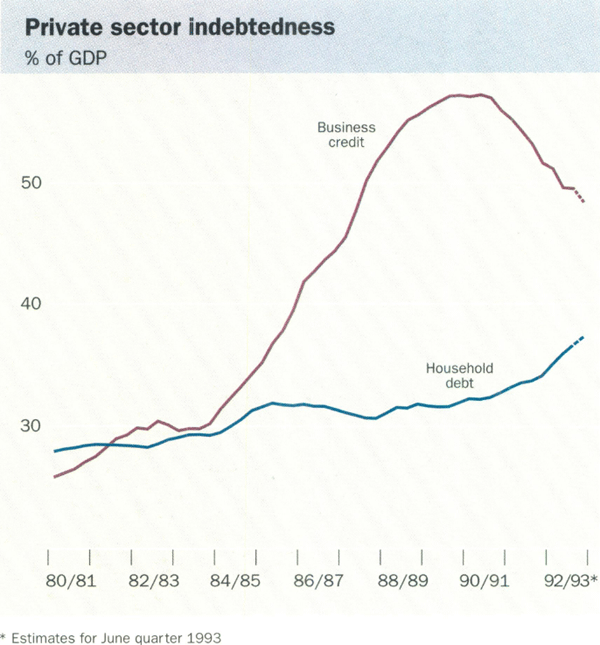
The effects of financial adjustment can be seen in the different behaviour of firms and households. In the early stages of recovery, the main impetus to growth in the private sector was, as usual, an expansion in house-hold spending on consumption and on housing. The behaviour of consumption and housing investment in this phase was qualitatively similar to earlier recoveries, if not quite as strong. It was facilitated by the relatively conservative financial strategy followed by most households during the 1980s. Businesses, on the other hand, have been battling with the legacy of high debt built up during the 1980s; the imperative to control and reduce this debt forced many firms into a defensive position early in the cycle.
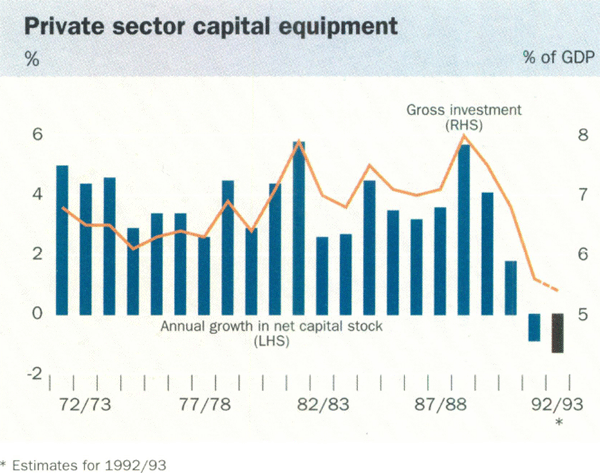
The divergence between the two sectors is apparent in the statistics for credit provided by financial intermediaries. Credit to house-holds has increased substantially over the past two years, whereas credit outstanding to the business sector has fallen, as companies have taken steps to reduce their borrowings. Much of the proceeds of strong equity raisings by companies over the past two years has gone to repay debt.
Efforts by corporations to reduce debt and restructure their balance sheets have had important implications for investment and employment. Many businesses have cut investment spending, especially the construction of commercial properties. Construction of hotels and offices appears to have fallen most sharply, although shops and factories also show big declines.
|
1989/90 |
1990/91 |
1991/92 |
1992/93 (to December) |
||
|---|---|---|---|---|---|
| Change in total liabilities: | 24.4 | 8.7 | 3.1 | 5.6 | |
| Of which: | Debt | 23.6 | 9.3 | −9.7 | −1.7 |
| Equity | 0.9 | −0.6 | 12.8 | 7.3 | |
|
Source: ABS Financial Accounts, Cat. No. 5232.0 |
|||||
|
Hotels |
Shops |
Factories |
Offices |
Other construction |
Engineering |
Total |
|
|---|---|---|---|---|---|---|---|
| Rise 1986 to 1989 | 135 | 104 | 150 | 160 | 113 | 174 | 145 |
| Fall since 1990, peak to trough | −73 | −50 | −45 | −63 | −34 | −9 | −42 |
|
* Data smoothed by taking a four-quarter moving average Source: ABS Building Survey, Cat. No. 8752.0 |
|||||||
Equipment investment too has suffered a large fall and, as a share of GDP, has been lower than at any other time in the past 40 years. As well as can be estimated, the private business sector's capital stock appears to have declined in both 1991/92 and 1992/93.
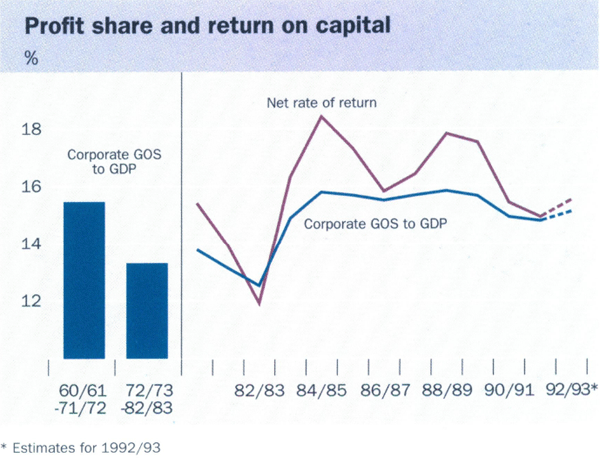
For many firms, the push to reduce debt is now easing. Measures of aggregate gearing have fallen, and many firms now have quite low leverage. The decline in interest rates also has helped cash flows, and interest cover is at its highest since the early 1980s. Given these conditions, strong growth in business investment could occur as the negative influences are lifted.
Equipment investment appears to have bottomed, although there is little evidence yet of the rebound necessary to restore the economy's productive potential. Continuing uncertainty about the state of the world economy is a dampening factor, as is the large overhang of unused capacity in many areas. Other influences on investment are more promising: the profits share of national income is relatively high, as is the aggregate rate of return on capital, while the strength in the share market has helped reduce the cost of equity capital.
In addition to tackling their debt burdens, businesses have been making a determined attack on costs generally, with substantial labour-shedding. This has occurred particularly in larger organisations, in both the private and public sectors, and has affected blue and white-collar workers. It has been a response not only to short-term cyclical pressures, but also to profound structural changes occurring across the economy. Job losses in big organisations have roughly offset the growth in numbers employed by small businesses and total employment has been flat over the past two years. Public sector employment has fallen in most States and most areas of government, with the biggest falls concentrated in government business enterprises. These falls, and the weakness in white-collar occupations generally, contrast with previous business cycles, when rises in such areas at least partly offset declines in manufacturing and other (predominantly blue-collar) sectors.
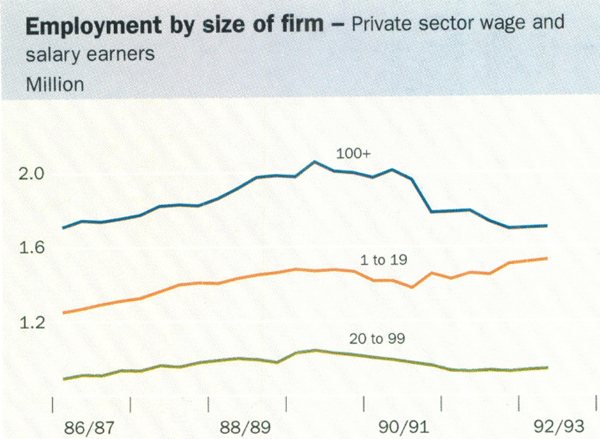
Structural adjustment of this kind has important longer-run benefits but its short-run effect has been to hold down employment. Some signs of increased demand for labour are beginning to emerge in the private sector, with a turn-up in job vacancies, relatively more placements in full-time jobs, and rising levels of overtime. So far, however, these signs have been quite weak compared with past experience, and unemployment remained around 11 per cent during 1992/93.
The sluggish performance of employment held back growth in household incomes, thereby constraining consumer spending. The value of retail trade, for example, was only 2.6 per cent higher in the three months to May 1993 than it had been a year earlier. Allowing for even modest price rises, this implies only a small increase in real terms. Over the year to June 1992, in contrast, real retail trade had grown by over 4 per cent. For housing activity, weak household income growth was less of a constraint, given the decline in borrowing costs and stability of house prices. Dwelling investment continued to expand, although it was showing signs of levelling out by mid 1993.
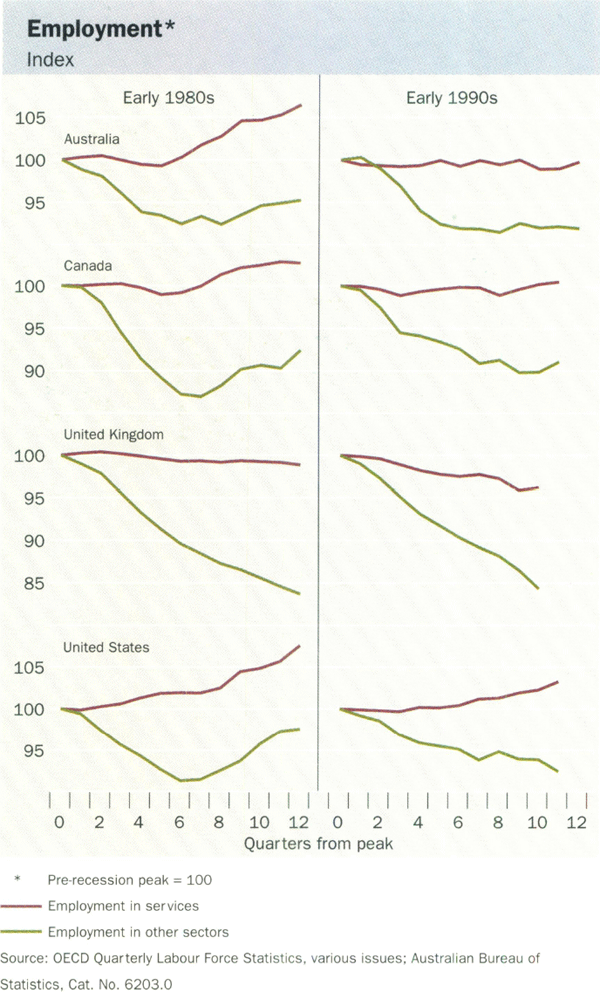
With modest growth in private consumption and business investment spending still weak, public sector expenditure played an increasingly important role in sustaining domestic demand. Some delays in implementing the “One Nation” and other decisions restrained government spending during the first half of 1992/93, but the pace quickened during the second half of the year.
Inflation
Australia recorded another year of low inflation in 1992/93, with underlying inflation around 2 per cent. This again compared favourably with the performance of traditionally low inflation countries.
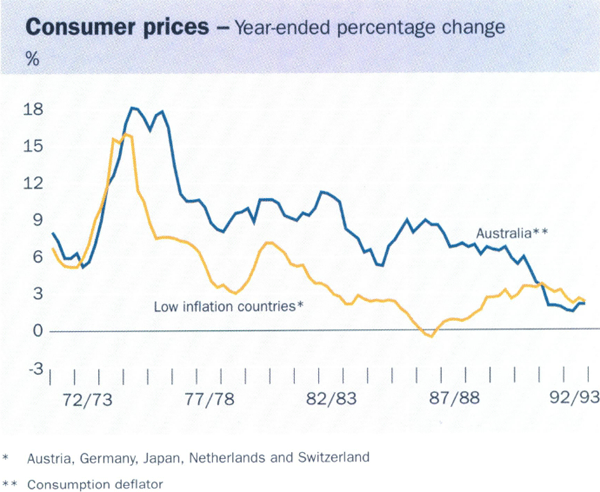
The published or “headline” CPI rose by 1.9 per cent over the year to June, a little higher than the rise recorded in the preceding year (1.2 per cent). This lift reflected the winding-down of some favourable “special” factors – principally the effects of falling mortgage interest rates – which had held down the headline rate during 1991/92, and increases in State government taxes and charges, which added about one percentage point to the total CPI over the year. Net of these tax effects and interest charges, prices for goods and services provided by the private sector rose by around 1¾ per cent between June 1992 and June 1993, a little less than in the preceding 12 months.
Other price series confirm a continuing low inflation picture. The fixed-weight deflator for GDP from the National Accounts rose by around 1 per cent over the year to March. Narrower measures of producer prices rose a little faster, with those for manufacturers reflecting the cost of higher imported inputs. Measures of construction costs were pushed up in part by stronger activity in the housing sector, and a significant rise in international timber prices. Despite such influences, however, the rises in these indices remained small.
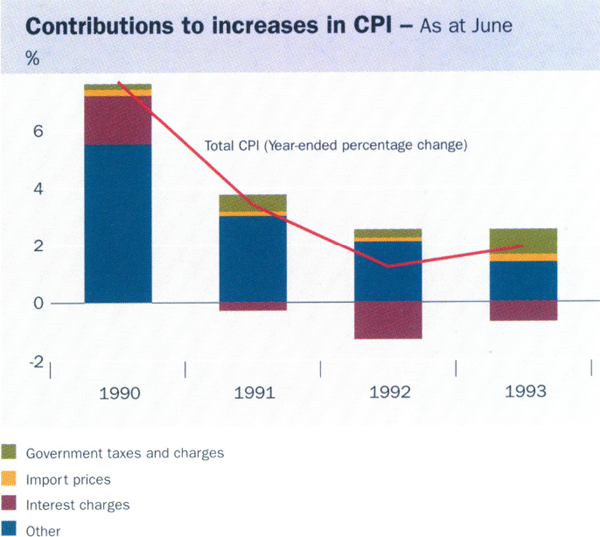
| June 1991 | June 1992 | Latest | |
|---|---|---|---|
| Consumer prices | |||
| Consumer price index | 3.4 | 1.2 | 1.9(1) |
| Private sector goods and services* | 4.1 | 2.1 | 2.5(1) |
| Adjusted for tobacco taxes | 3.8 | 1.9 | 1.8(1) |
| Private consumption deflator# | 3.8 | 2.1 | 2.3(2) |
| Producer prices | |||
| Manufacturing input prices | 3.3 | 3.5 | 1.7(3) |
| Imported goods prices | 2.2 | 2.3 | 9.8(3) |
| Manufacturing output prices | 2.7 | 1.3 | 2.1(3) |
| House building materials prices | 2.7 | −0.3 | 4.0(3) |
| Other building materials prices | 3.3 | −1.0 | 1.4(3) |
| Broader measures | |||
| Domestic final demand deflator* | 3.0 | 1.6 | 2.3(2) |
| Gross Domestic Product deflator# | 1.9 | 1.3 | 1.1(2) |
| Nominal labour costs | |||
| Award wages | 2.6 | 3.4 | 0.9(3) |
| Private sector ordinary-time earnings | 4.3 | 4.4 | 0.4(4) |
| Unit labour costs | 1.8 | 2.6 | 1.6(2) |
|
* Total CPI less fresh fruit and vegetables, fuel, mortgage interest charges,
consumer credit charges, public dwelling rents, local government rates
and charges, household fuel and light, postal and telephone services, motoring
charges, urban transport fares, health services, pharmaceuticals, and education
and child care Sources: Australian Bureau of Statistics, Commonwealth Treasury and Reserve Bank |
|||
The modest rises in prices at both the producer and consumer levels constituted a good outcome, given the fall in the exchange rate. The first major phase of this fall, between September 1991 and August 1992, added about 11½ per cent to import prices across the docks in the nine months to January 1993. The “pass-through” into retail prices has been much slower. Prices of predominantly imported goods and services included in the CPI, as identified by the Statistician, rose by only 3 per cent in the year to June 1993 and contributed only about 0.3 of a percentage point to the rise in the CPI. The full effect of the lower exchange rate is probably bigger than this, as some key consumer goods include imported components (eg motor vehicles). To date, however, these effects in general appear to be having a much smaller impact on consumer prices than occurred in the mid-1980s episode of substantial exchange rate depreciation.
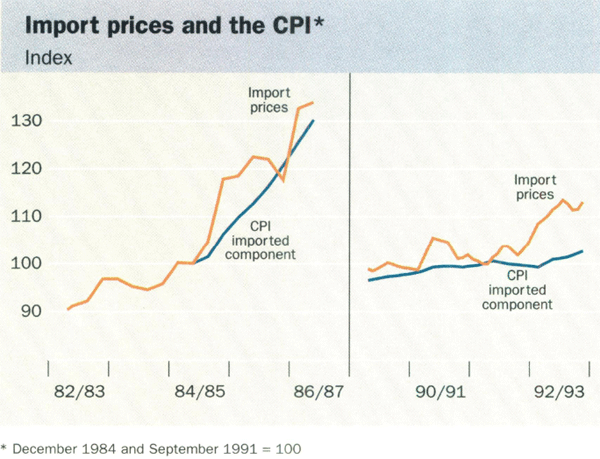
Over May and June 1993, the TWI fell by a further 5 per cent, which implies some further rise in import prices and import valuation effects. The continuing slack in product and labour markets should assist in coping with the short-term inflationary consequences; whether there is any lasting impact on the rate of inflation will hinge largely on wage outcomes.
Growth in labour costs has been very subdued. Average weekly ordinary-time earnings rose by 1.8 per cent during 1992/93, compared with 4.7 per cent in the previous year. For private-sector workers, the rise was slower, at 0.4 per cent over the year to February (the latest available figure). The rise for public-sector workers, a bigger proportion of whom have struck enterprise bargains, was 1.8 per cent in the year to February, down a little from the previous year. With increasing labour productivity, unit labour costs have risen only slowly over recent quarters.
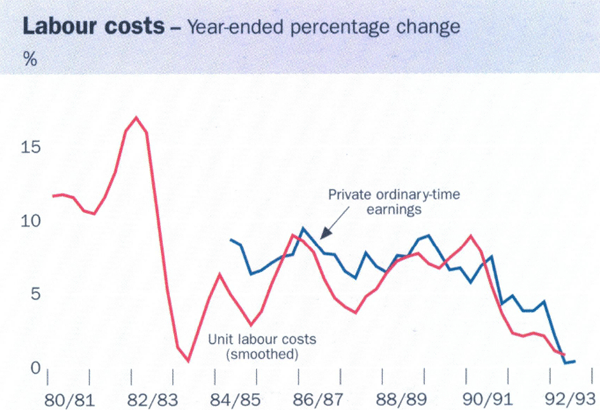
Wage negotiations in Australia are continuing to evolve towards the decentralised model of enterprise bargaining. To date, about 12 per cent of employed wage and salary earners have been party to enterprise agreements with their employers. These agreements have provided for wage increases, some of which include an “economic adjustment” (related to expected price rises), as well as some productivity improvements. In macroeconomic terms, the best outcome would see further genuine productivity bargains struck as the system spreads, along with minimal “economic adjustments” in recognition of continuing low inflation and high unemployment. That would help to maintain the recent decline in the “real” exchange rate and associated gain in competitiveness, with beneficial effects on economic activity, employment and trade.
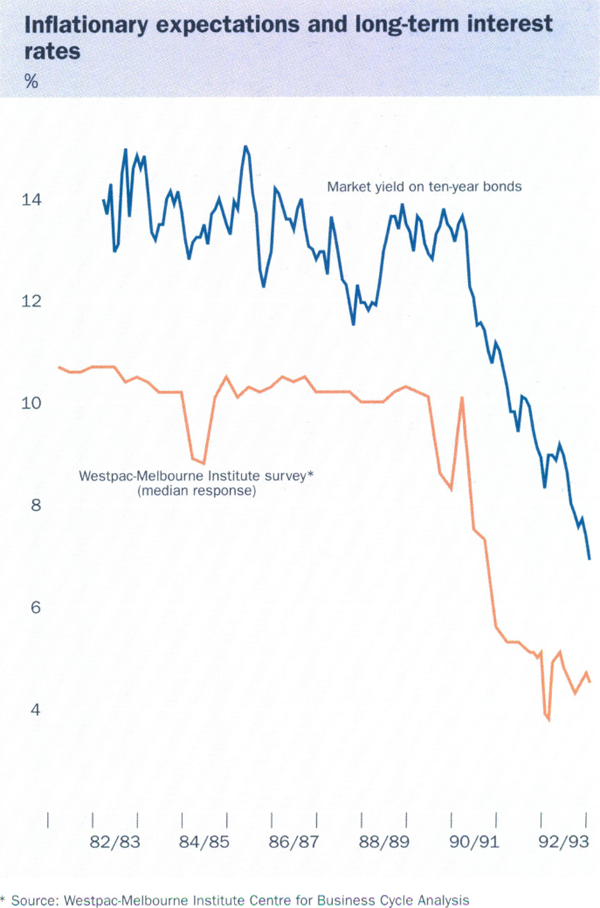
Inflationary expectations have fallen further. The Westpac-Melbourne Institute's latest survey of consumers shows a median expectation of inflation over the next 12 months of around 4½ per cent. A year earlier the comparable figure was 5 per cent, suggesting that the process of adapting to low inflation is continuing. The great majority of businesses believe that inflation will remain low in the 1990s, and economists' inflation forecasts are lower than they were a year ago. Long-term security yields also reflect greater optimism on inflation. Despite some setbacks to confidence, and the fall in the exchange rate, the yield on 10-year government bonds was just under 7 per cent by end July 1993, compared with just under 9 per cent in June 1992.
The international environment and Australia's balance of payments
The disappointing pace of recovery in Australia so far is paralleled in a number of other countries where economic activity at best remains hesitant and patchy; some economies are still contracting. Overall, 1993 marks the third successive year of weak growth of the global economy, making the downturn comparable with those in the early 1980s and mid 1970s. Against that, the industrialised countries, with the notable exception of Germany, are recording their lowest rates of inflation in two or three decades.
The divergences evident earlier among the three largest economies continued during 1992/93. In the United States, the expansion picked up a little, but the pace remained moderate. Signs of a boost to growth after the Presidential election faded, and real GDP rose by about 2½ per cent over the year to June. This was enough to generate some growth in employment, and to lower the unemployment rate. With the process of balance-sheet restructuring more advanced than in most countries, the US economy looks to be well placed to sustain its recovery. The concerns about a resurgence of inflationary pressures which emerged during the first half of 1993 appear to have been premature.
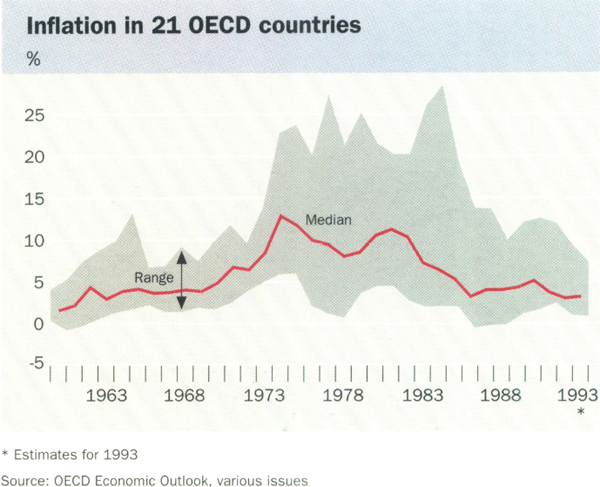
In Europe, the full implications of German unification and tight monetary policies became clearer during 1992/93. Economic activity in countries associated with the Exchange Rate Mechanism (ERM) languished, and the system itself came under pressure; two countries suspended their participation in the ERM while some others devalued their currencies within it. Germany itself has been experiencing one of its biggest contractions in economic activity since the Second World War, while its inflation rate has been stuck around 4 per cent.
In Japan also the downturn has proved severe. Asset-price deflation has had pronounced effects, but the healthy state of government finances and low inflation have provided the scope for stimulatory fiscal action. The Japanese Government has used that latitude to enact two major fiscal packages over the past year. The true impact of the packages is thought to be somewhat smaller than the 5 per cent of GDP suggested by the headlines, but it is substantial nonetheless. This fiscal action should help to restore growth to more normal levels over the next 12 months, although political uncertainties and the high yen remain negative influences.
The dynamic economies of East Asia again recorded much stronger growth in 1992/93 than the older industrialised economies. China grew at double-digit rates, although mounting inflationary pressures have increased the likelihood of further policy measures being taken to moderate the expansion. Slower growth was recorded in South Korea, where policies have sought to check inflation, but growth picked up in both Singapore and Hong Kong. Intra-Asian trade has continued to grow rapidly.
|
Share of Australian exports* |
Growth in real GDP Year to December |
||
|---|---|---|---|
| 1991 | 1992 | ||
| South Korea | 5.9 | 7.7 | 2.5 |
| Singapore | 5.0 | 6.4 | 7.4 |
| New Zealand | 5.1 | −1.5 | 3.0 |
| Taiwan | 4.0 | 7.3 | 6.3 |
| Hong Kong | 3.2 | 5.0 | 5.1 |
| China | 2.5 | 7.8 | 12.8 |
|
* Average of years 1988/89 – 1991/92 Source: Australian Bureau of Statistics and national sources |
|||
The current account deficit was $15.3 billion (3¾ per cent of GDP) in 1992/93, up from $12.4 billion (3¼ per cent) in the previous year. This widening reflected mainly the weak world economy, which has been accompanied by falling commodity prices and slow growth of export demand from OECD countries, and the continuing, if hesitant, recovery in Australia, which has helped to raise import volumes.
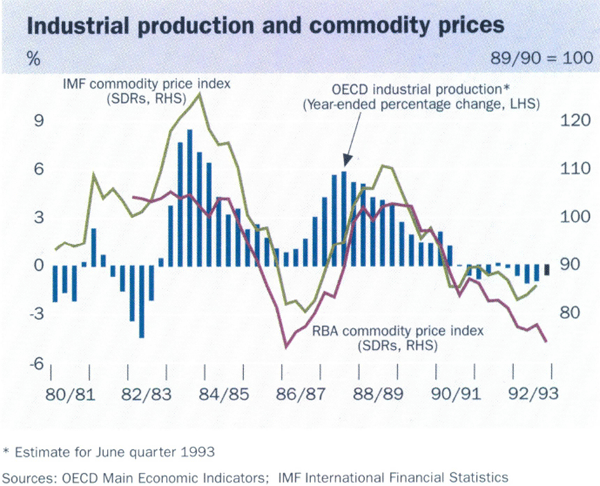
Manufactured export volumes again rose substantially but resource-based exports slowed, reflecting lower growth in all categories. The latest contracts for both coal and iron ore provide for reduced tonnages to be shipped to Japan in 1993/94, but demand from other Asian countries is expected to remain firm. Rural export volumes grew, with wheat exports recovering from their drought-affected lows, and meat exports also rising.
| Real GNE | Real imports | ||
|---|---|---|---|
| Merchandise | Goods and services | ||
| Jun 91 – Mar 93 | 5.6 | 11.6 | 9.3 |
| Jun 83 – Mar 85 | 12.6 | 26.6 | 25.7 |
|
Source: Australian Bureau of Statistics |
|||
Imports rose by around 16 per cent in 1992/93. Valuation effects flowing from the lower exchange rate – down 10 per cent, on average, from the previous year – accounted for much of this rise, but import volumes also rose. The monthly and quarterly statistics are quite volatile but, taking a longer perspective, the volume of imports of goods and services, by the March quarter, had risen by close to 10 per cent since the trough in domestic demand in the June quarter of 1991. This growth, relative to the rise in domestic demand, was broadly similar to that observed in the previous recovery.

Higher imports and weak export prices reduced the surplus on merchandise trade to $0.6 billion in 1992/93, from $3.9 billion in 1991/92. Combined with a slightly larger deficit on services, this moved the balance on goods and services back into deficit. Cyclical fluctuations apart, however, Australia's trade accounts have made a modest structural improvement over the 1980s and early 1990s. The balance on goods and services recorded a surplus equivalent to about 0.6 per cent of GDP at its peak in 1991; this compared with a deficit of around 0.6 per cent of GDP reached in 1983, at a time when export prices were much more favourable. The strong rise in merchandise exports, particularly over the second half of the 1980s, and the growth in tourism, have been key factors in this improvement.
Net income payments abroad declined in 1992/93, and since 1990/91 have fallen by $4.2 billion or the equivalent of 1 per cent of GDP. This mainly reflects a reduction in domestic and foreign interest rates, which has reduced the cost of servicing the stock of foreign liabilities. The longer-term trend in the net income deficit has been upwards, however, roughly offsetting the structural improvement in the goods and services trade account.
The capital flow counterpart of the current account deficit during 1992/93 was mainly in the form of inflows to the official sector, with only weak demand for capital in the private sector. State governments in particular substantially increased their borrowing abroad, and holdings of foreign assets by the Reserve Bank fell. Net liabilities owed abroad by Australians rose to $208 billion as at March 1993, (around 52½ per cent of GDP), compared with $199 billion in June 1992 (51½ per cent of GDP). About one quarter of the nominal rise over this period reflected valuation changes resulting from the fall in the Australian dollar.
Economic growth in the 1990s
For several years now, the Australian economy has been undergoing a painful process of change. That process has not been aided by the 2–3 per cent growth rates recorded over the past year and a half which are not sufficient either to reduce unemployment or encourage new investment in future growth.
How to achieve and sustain higher rates of growth is the challenge for today's policy-makers. For the moment, winding back the consequences of excessive borrowing in the late 1980s is proving to be more protracted than expected. Overlaid on this process is ongoing structural change driven largely by the frontal exposure of the economy to international disciplines and opportunities. The transition to low inflation also has required some major shifts in thinking, which are not yet complete. These factors, taken together with the unhelpful international environment, dampen somewhat the prospects for a sharp, policy-induced rebound; a stronger world economy, in particular, is not in the gift of Australian economic policy.
Rather, once the macroeconomic counter-cyclical cards have been played, domestic policies need to cultivate an environment conducive to helping Australians to do better in the circumstances which currently prevail, and to be poised to exploit the pick-up in the world economy when it comes. Australia has many inherent advantages, not least natural and human resources, political stability, quality infrastructure, and proximity to the fast-growing Asian economies. Turning those advantages into a successful and sustained growth performance, however, requires a number of additional elements.
From the Bank's point of view, one which looms large is a stable price framework. This is essential if we are to hold the gains on competitiveness and generate the quality investment necessary to increase future output. Monetary policy carries much of the responsibility here, although other policies (such as wages and taxation policies) can make monetary policy's job more or less difficult. The consistent application of monetary policy will help to keep inflation at low levels – in underlying terms, of the order of 2 to 3 per cent over a run of years.
On its own, however, price stability will not guarantee faster growth. The main requirement for higher sustained growth is higher investment. Low inflation will make for better quality investment, but higher overall levels of investment also are required. Many of the prerequisites for this are in place – costs are contained, profitability is relatively good for this stage of the cycle, debt burdens and interest costs are down and various taxation incentives are in place. The missing factor is the confidence to expand in anticipation of future sales and profits. This in turn depends on various factors and cannot be drummed up easily; it will, however, be responsive to policies which are generally supportive of growth, and which minimise impediments to investment and hiring decisions.
Financing that necessary investment raises some critical issues. Rapid and sustainable growth tends to be associated with countries with high saving rates. While a temporary fall in savings by both house-holds and governments in the recession is normal, Australians – both as individuals and through their governments – need to lift their savings performances over the medium term. Compulsory superannuation can help but these arrangements work best where employees accept lower current consumption standards in return for higher future incomes; attempts to realise higher living standards at both points in time by passing the cost onto employers will risk dissipating the potential gains from savings through higher prices.
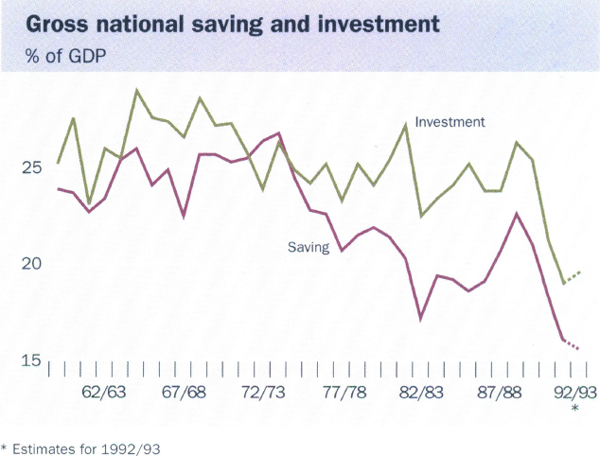
The Government's own contribution to national savings has to be resumed in the near term. The fiscal stimulus by the Commonwealth, together with the impact of the weak economy and low inflation on revenue growth, has pushed government borrowing requirements up over recent years. The Commonwealth's deficit increased to $14.6 billion in 1992/93, around 3½ per cent of GDP, with the total public sector deficit estimated at over 5 per cent of GDP. Excluding asset sales, which gives a more accurate picture of the public sector's call on savings, the PSBR was around 6 per cent of GDP, not far below the previous peak in 1983/84. Another large borrowing requirement is in prospect in 1993/94. This is appropriate given the sluggishness of the recovery, but a credible policy of short-term fiscal stimulus needs to be accompanied by firm measures to wind back the deficit over time.
The financial system plays an important role in mobilising savings. For all the difficulties of recent years, which were common to a number of countries, Australia now has a financial system which is much more competitive and efficient than it was in the past. Banks (and non-banks) have been getting on top of their difficulties and as they regain their strength, they can be expected to do more to make the economy stronger.
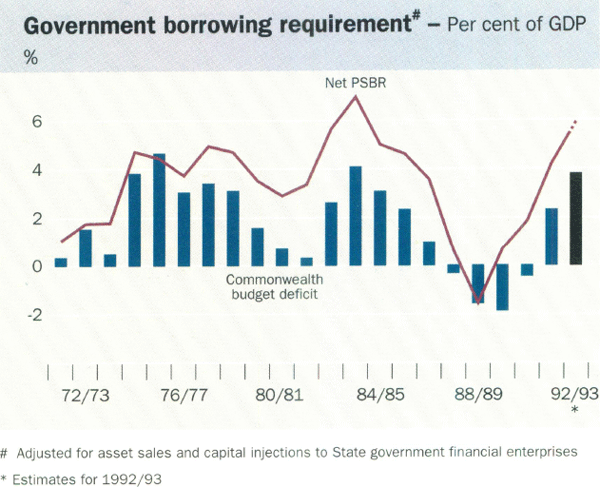
A flexible, responsive economic structure is also a necessary condition for sustained growth. Many positive changes are under way, including the expansion of manufactured exports and tourism, increases in productivity in both public and private enterprises, and the shift towards decentralised wage-bargaining arrangements. The emerging renaissance in manufacturing is just one of these changes which can be built on, without diverting attention from the further growth potential of Australia's efficient mining and agricultural activities.
Changes in the labour market over recent years have been moving in ways compatible with the challenge of overseas competition. As these changes continue, they can be expected to lead to a greater dispersion of relative wage levels, with increasing rewards for skills, initiative and effort. Traditional notions of comparative wage justice will come under challenge in this process but a flexible labour market is an important key to higher growth and living standards for the whole community. At the same time, and particularly during the current transitional period, aggregate wage outcomes remain important. Policy-makers should not abandon the idea of influencing these outcomes, even though some of the old mechanisms for doing so (such as national wage cases) may no longer be operational. A degree of consensus among governments, unions and businesses on appropriate wage “norms” would buttress the anti-inflationary stance of monetary policy, and help in finding sufficient jobs for people seeking them.
These factors are among the many components of a sound long-run growth strategy. None of them alone is sufficient but, together, they establish a powerful basis for prosperity.
Two years into recovery, growth has remained disappointingly slow. A weak world economy, and protracted financial and other adjustments at home, have been important factors. Public policy cannot manufacture higher employment and rising incomes in short order, but sensible policies, consistently applied, can help Australians make the 1990s a decade of growth.